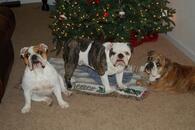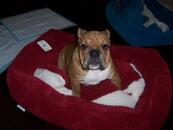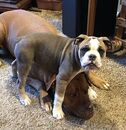Keratoconjunctivitis sicca, or KCS, is also known as dry eye syndrome. “Kerato” refers to the cornea of the eye, “conjunctivae” are the pink membranes in the eye socket, “itis” means inflammation, and “sicca” means dry.
KCS means there is a dry, inflamed cornea and conjunctiva caused by a deficiency of the water portion of the tear film over the eyeball and in the lid lining.
Normal tear production provides a number of benefits to the eye including lubrication, anti-bacterial agents, and the flushing away of irritants and infectious agents. Your pet's tears come from two lacrimal glands in each eye – one is located just above the eye and the other is in the third eyelid.
Dry eye is a condition in which the tear mixture, which consists of oil, mucus and mostly water, is absent the water. Only oil and mucus are being secreted, which is why pets with KCS have thick, yellow discharge from their eyes. The eyes get red and the cornea in time turns brown. If the condition isn't treated, blindness can result.
Causes of Dry Eye
There are a number of causes of dry eye. The most common is immune mediated destruction of tissue in tear-producing glands, a situation that is often seen in Cocker Spaniels, Miniature Schnauzers, and West Highland White Terriers. Brachycephalic breeds (“smashed nose” breeds) with bulging eyes are also predisposed to KCS.
There are several other possible underlying causes for the condition, including canine distemper, herpes-related feline upper respiratory infection, trauma to the head, exposure to certain antibiotics and anesthesia, and removal of the third eyelid lacrimal gland which sometimes occurs during surgery for cherry eye.
If your pet has cherry eye, which is what we call it when the lacrimal gland pops out, I recommend you ask your veterinarian to surgically replace the gland rather than simply cutting it out. If the gland is removed, your pet will not produce tears for the remainder of his or her lifetime.
Diagnosing Dry Eye
Advanced KCS is obvious to the naked eye, but early on, it may look like a simple case of conjunctivitis. Once the condition has progressed, it’s very obvious. The eyes appear extremely dry, the corneas are brown, and it looks as though mucus and other debris is oozing from the eye.
Your vet will want to know your pet’s history, symptoms, and possible events that may have contributed to the condition. An eye exam will be performed, as well as a test called the Schirmer tear test to measure the amount of tear production from the tear ducts and how much is available for the eye. A low level points to KCS.
The tear test is performed by placing a strip of special paper just inside the lower eyelid in the outer corner of the eye. The paper is left in place for 60 seconds to allow the moisture in the eye to wet it. At the end of the minute, the length of the moistened area on the paper is measured. A length of 15mm or more is normal. A length 11 to 14mm is borderline. A length of less than 10mm is dry, and a length of less than 5mm is severely dry.
Pets with dry eye are predisposed to corneal ulcers, so your vet may also use a fluorescein stain to check the eyes for abrasions or ulcerations. A sample of aqueous fluid may be taken for a culture and sensitivity test to measure the bacterial growth in the eye and whether there may be an underlying infection as well.
Treatment Options
Treatment of dry eye syndrome typically involves topical medications like artificial tears and lubricants that will be necessary in most cases for the rest of your pet’s life.
If an underlying disease, allergy or infection is identified as the cause of the dry eye, it will also need to be treated. Any corneal ulcers will need to be treated as well until they are completely resolved.
Depending on the root cause of the lack of tear production, certain prescription eyedrops will be given. If there’s an underlying autoimmune disorder, tacrolimus or cyclosporine eyedrops are beneficial for reducing the immune-mediated destruction of the tear gland.
There is a surgical procedure for KCS called the parotid duct transposition, but it is highly complex and requires a great deal of post-surgical lifetime maintenance. The procedure should only be performed by a veterinary ophthalmologist. It’s performed less frequently since newer eyedrops have been introduced.
Rechecking the tear gland using the Shirmer test is important in all cases of dry eye, because that’s how veterinarians know whether the condition is improving, or getting worse.
Additional Help for Pets with Dry Eye
Owners of pets with KCS need to keep the eyes clean and free of discharge. It’s also important to clean your pet’s eyes before applying medication, as secondary infections are very common.
There are homeopathics and Chinese herbs that can be given orally that can be beneficial in improving tear production. However, many pets have progressively less tear production over time, which means their owners will be required to supply tears topically. The less tear production your pet has, the more responsibility you must assume for lubricating the eyes.
Animals with very poor tear production will need their eyes lubricated many times each day. Obviously, these pets become very high maintenance in terms of keeping their eyes moist. But it’s really the only way to keep your pet feeling comfortable.
Never use Visine or any over-the-counter human medicated eyedrops for eye irritation in pets. There are a few natural tear products for humans, both drops and gels, which your vet may recommend, but never assume a human eye product is safe for your pet without consulting your vet first.
Animals with KCS are highly susceptible to corneal ulceration and other eye injuries, so it’s important to watch for signs your pet might be in pain so you can get him to the vet before serious injury to the eye occurs.
If it seems your pet is constantly producing eye debris… or if as soon as you clean your pet’s eyes you need to clean them again... or if your pet is continually pawing at his face or rubbing his head up and down the couch because his eyes are irritated, I recommend you make an appointment with your vet for a Shirmer tear test to check for dry eye.
The sooner you identify a lack of adequate tear production, the sooner you can begin a treatment protocol to help improve your pet’s ocular health. Holistic practitioners have very good success using homeopathy, Chinese herbs, antioxidants and nutraceuticals to improve tear production in mild to moderate cases of dry eye. And these modalities can be combined with prescription eyedrops to slow the progression of disease in many cases.
KCS means there is a dry, inflamed cornea and conjunctiva caused by a deficiency of the water portion of the tear film over the eyeball and in the lid lining.
Normal tear production provides a number of benefits to the eye including lubrication, anti-bacterial agents, and the flushing away of irritants and infectious agents. Your pet's tears come from two lacrimal glands in each eye – one is located just above the eye and the other is in the third eyelid.
Dry eye is a condition in which the tear mixture, which consists of oil, mucus and mostly water, is absent the water. Only oil and mucus are being secreted, which is why pets with KCS have thick, yellow discharge from their eyes. The eyes get red and the cornea in time turns brown. If the condition isn't treated, blindness can result.
Causes of Dry Eye
There are a number of causes of dry eye. The most common is immune mediated destruction of tissue in tear-producing glands, a situation that is often seen in Cocker Spaniels, Miniature Schnauzers, and West Highland White Terriers. Brachycephalic breeds (“smashed nose” breeds) with bulging eyes are also predisposed to KCS.
There are several other possible underlying causes for the condition, including canine distemper, herpes-related feline upper respiratory infection, trauma to the head, exposure to certain antibiotics and anesthesia, and removal of the third eyelid lacrimal gland which sometimes occurs during surgery for cherry eye.
If your pet has cherry eye, which is what we call it when the lacrimal gland pops out, I recommend you ask your veterinarian to surgically replace the gland rather than simply cutting it out. If the gland is removed, your pet will not produce tears for the remainder of his or her lifetime.
Diagnosing Dry Eye
Advanced KCS is obvious to the naked eye, but early on, it may look like a simple case of conjunctivitis. Once the condition has progressed, it’s very obvious. The eyes appear extremely dry, the corneas are brown, and it looks as though mucus and other debris is oozing from the eye.
Your vet will want to know your pet’s history, symptoms, and possible events that may have contributed to the condition. An eye exam will be performed, as well as a test called the Schirmer tear test to measure the amount of tear production from the tear ducts and how much is available for the eye. A low level points to KCS.
The tear test is performed by placing a strip of special paper just inside the lower eyelid in the outer corner of the eye. The paper is left in place for 60 seconds to allow the moisture in the eye to wet it. At the end of the minute, the length of the moistened area on the paper is measured. A length of 15mm or more is normal. A length 11 to 14mm is borderline. A length of less than 10mm is dry, and a length of less than 5mm is severely dry.
Pets with dry eye are predisposed to corneal ulcers, so your vet may also use a fluorescein stain to check the eyes for abrasions or ulcerations. A sample of aqueous fluid may be taken for a culture and sensitivity test to measure the bacterial growth in the eye and whether there may be an underlying infection as well.
Treatment Options
Treatment of dry eye syndrome typically involves topical medications like artificial tears and lubricants that will be necessary in most cases for the rest of your pet’s life.
If an underlying disease, allergy or infection is identified as the cause of the dry eye, it will also need to be treated. Any corneal ulcers will need to be treated as well until they are completely resolved.
Depending on the root cause of the lack of tear production, certain prescription eyedrops will be given. If there’s an underlying autoimmune disorder, tacrolimus or cyclosporine eyedrops are beneficial for reducing the immune-mediated destruction of the tear gland.
There is a surgical procedure for KCS called the parotid duct transposition, but it is highly complex and requires a great deal of post-surgical lifetime maintenance. The procedure should only be performed by a veterinary ophthalmologist. It’s performed less frequently since newer eyedrops have been introduced.
Rechecking the tear gland using the Shirmer test is important in all cases of dry eye, because that’s how veterinarians know whether the condition is improving, or getting worse.
Additional Help for Pets with Dry Eye
Owners of pets with KCS need to keep the eyes clean and free of discharge. It’s also important to clean your pet’s eyes before applying medication, as secondary infections are very common.
There are homeopathics and Chinese herbs that can be given orally that can be beneficial in improving tear production. However, many pets have progressively less tear production over time, which means their owners will be required to supply tears topically. The less tear production your pet has, the more responsibility you must assume for lubricating the eyes.
Animals with very poor tear production will need their eyes lubricated many times each day. Obviously, these pets become very high maintenance in terms of keeping their eyes moist. But it’s really the only way to keep your pet feeling comfortable.
Never use Visine or any over-the-counter human medicated eyedrops for eye irritation in pets. There are a few natural tear products for humans, both drops and gels, which your vet may recommend, but never assume a human eye product is safe for your pet without consulting your vet first.
Animals with KCS are highly susceptible to corneal ulceration and other eye injuries, so it’s important to watch for signs your pet might be in pain so you can get him to the vet before serious injury to the eye occurs.
If it seems your pet is constantly producing eye debris… or if as soon as you clean your pet’s eyes you need to clean them again... or if your pet is continually pawing at his face or rubbing his head up and down the couch because his eyes are irritated, I recommend you make an appointment with your vet for a Shirmer tear test to check for dry eye.
The sooner you identify a lack of adequate tear production, the sooner you can begin a treatment protocol to help improve your pet’s ocular health. Holistic practitioners have very good success using homeopathy, Chinese herbs, antioxidants and nutraceuticals to improve tear production in mild to moderate cases of dry eye. And these modalities can be combined with prescription eyedrops to slow the progression of disease in many cases.





